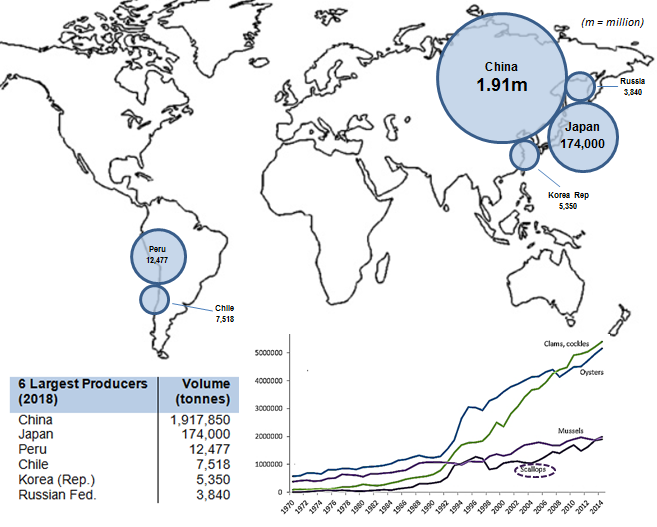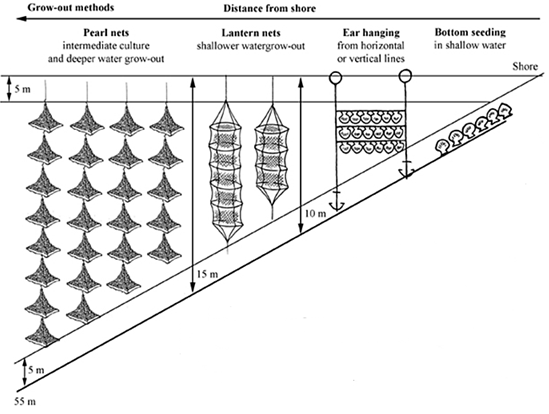Scallops
Various species
Sources, Quantities and Cultivation Methods
Sources and Quantities
Global capture fisheries cannot meet demand for scallop due to overfishing and scallop farming has become an increasingly important global aquaculture activity1. Scallops are farmed across the world in cold and warm water regions, and include over ten different species both native and introduced, as shown in the table below2.

Scallops are filter feeding bivalve molluscs that live mainly on sand or gravel sea bed from 30-40m deep up to shallow waters, but not exposed at low tide. Large scallop species can have a life-span of up to 20 years. Market value of scallops is closely related to their size however, harvesting farmed scallops at various sizes may be economically preferable depending on the market.
Scallops are farmed across the globe, and was worth over US$5.8 billion in 2018 from a production total of 2.12 million tonnes. China produced over 90% of this volume. Other important producing countries are Japan, Peru, Chile South Korea and Russia which together produced almost 204,000 tonnes in 20162.

China produces over 80% of the world's bivalves, but domestically consumes almost all of this production. Less than 5% of total world bivalve production enters international markets; one of the lowest proportions in seafood trade. This is due to the very nature of bivalves, which are highly perishable and potentially pose a risk to human health if not properly handled. The EU is one of the main markets for bivalves taking over one-third of the total bivalve trade Around 150,000 tonnes of scallop are internationally traded per year, and EU scallop imports are around 40,000 tonnes per year3, 4.
Scallop cultivation was developed in Japan in the late 1960s where it rapidly restored production to levels lost through overfishing5. Japanese success has encouraged other countries to cultivate scallops. In China, culture of the local zhikong scallop started in the 1970s, followed in 1982 by Bay scallops imported from the US. For both these species it was not possible to collect wild spat so large-scale hatchery culture was developed, followed by suspended culture in the sea. As zhikong scallop aquaculture increased natural spawning also increased enabling wild spat collection. Today, there is virtually no hatchery production of this species. In recent years there has been a sharp fall in zhikong scallop production caused by summer mortalities. To compensate there has been expanded production of non-native Bay and Japanese yesso scallops6.
Chilean culture of the Peruvian calico scallops started in the 1980s and is based on highly variable natural settlement on collectors, supplemented by hatchery production7. Peru followed similar methods and now exceeds Chilean production. Scallop production in this region can fluctuate widely due to El Niño effects4.
Domestic Market Information
Our domestic seafood market is complex mix of products from wild caught and farmed species, including scallops, which in recent years, have grown in popularity in Great British retail (i.e. in England, Scotland and Wales).
To discover more about the highly dynamic and ever-changing UK and Great British (GB) seafood marketplace, you can explore our user friendly and interactive Trade and Tariff in Tableau (T4) online tool. And visiting our dedicated Insight and Research pages will provide you with access to a wealth of information, from reports to factsheets on markets including:
- Retail – data from independent and multiple retailers in the UK used to reveal the latest insights on seafood eaten at home
- Foodservice – data from the foodservice industry in the UK used to highlight the latest trends on seafood eaten out of home
- Market supply – HM Revenue and Customs (HMRC) data used to detail what species and products are imported from, and exported to, the UK
To get the latest seafood market performance and trends delivered to your inbox, register at the Market Insight Portal.
Production Method1, 8
There are a variety of ways in which spat can be collected, including a series of mesh bags suspended in the water column on a line which is anchored to the seafloor (i.e., long-lining). Mesh bags are filled with a suitable cultch onto which scallop larvae will settle. In countries where natural spatfall is poor, or in the case of introduced scallops, spat can be hatchery reared. To prevent high mortality of scallop spat associated with early transfer to grow-out facilities there may be a nursery stage which helps to produce more robust juveniles.
There are two basic methods for scallop grow-out: hanging and bottom culture. Hanging culture relies on rafts or longlines from which scallops are suspended in various water depths and using a variety of techniques as shown in the Yesso scallop grow-out diagram below. Bottom culture employs the use of plastic trays or wild ranching on the seabed in shallower waters.

References
- Seafood Watch
- FAO FishstatJ
- GLOBEFISH
- SeafoodTIP
- Kosaka, Y, 2016. Scallop Fisheries and Aquaculture in Japan. Chapter 21 in Scallops: biology, ecology and aquaculture (Vol. 40)
- Guo, X. and Luo, Y., 2016. Scallops and Scallop Aquaculture in China. Chapter 22 in Scallops: biology, ecology and aquaculture (Vol. 40)
- Evans, Y. and Tveteras, S., 2011. NORAD/FAO project. Background Report. Status of fisheries and aquaculture development in Peru: Case studies of Peruvian Anchovy fishery, Shrimp aquaculture, Trout aquaculture and scallop aquaculture
- FAO